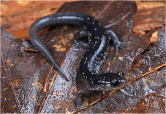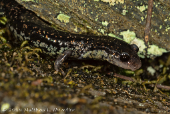Tellico Salamander (Plethodon aureolus)
Description: It has a grayish-black or black dorsum with brassy spotting. The chin is light-coloured and the sides have more concentrated yellow or white spotting. Rounded in cross section, the maximum size for adults is 5.9 inches from tip of the snout to tip of the tail.
Habitat: This species can be found in mountainous and lowland forested habitats, and it breeds terrestrially by direct development. Individuals are often found in woodland detritus and retreat underground during cold or dry conditions. Juveniles have been found in abundance in late summer under superficial covers such as twigs. This species appears to be relatively resilient to disturbances, specifically those associated with timber harvesting as individuals are frequently recorded from second-growth forests.
Range: This species is found between the Little Tennessee and Hiwassee Rivers on the western slopes of the Unicoi Mountains and nearby lowlands in northeastern Polk and eastern Monroe Counties in Tennessee, and in northwestern Graham and northwestern Cherokee counties in North Carolina. It has primarily been found at lower elevations but may range as high as 1,622 m asl in North Carolina. Its range is still poorly known.
Found in these States:
NC |
TN
Diet: A variety of invertebrates.
Reproduction: Sexually active males have circular mental glands just behind the chin. The courtship ritual performed is indistinguishable from P. glutinosus. It ends with the deposition of a spermatophore by the male which is picked up by the female's cloacal lips. Chemical cues are important in species recognition and prevention of interbreeding with P. oconaluftee. Males seem to prefer the odor of female conspecifics, while females tend to prefer the odor of male heterospecifics.
Status: Listed as Data Deficient since there is very little information on its extent of occurrence, population status, ecological requirements, and threats. Surveys on private lands are limited, and as this constitutes a large portion of the range the status of the habitat and ongoing activities in these areas are key to determining a listing. This degree of uncertainty makes it difficult to discern if this species could qualify for a threatened category or is suitable for Least Concern, therefore Data Deficient is the most appropriate category.
»» Kingdom: Animalia - Animals
»» Phylum: Chordata - Chordates
»» Subphylum: Vertebrata - Vertebrates
»» Class: Amphibia - (Amphibians)
»» Order: Caudata - Salamanders
»» Family: Plethodontidae - Lungless Salamanders
»» Genus: Plethodon
»» Species: Plethodon aureolus - Tellico Salamander
This article uses material from the Wikipedia article "Tellico Salamander", which is released under the Creative Commons Attribution-Share-Alike License 3.0. Content may have been omitted from the original, but no content has been changed or extended.
|












